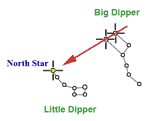“What if I were lost in the dark?” It’s a thought that has haunted humans – young and old alike – forever. There are lots of markers in the natural world for orienting yourself – the sun, lichen growing on the shady sides of boulders, Spanish Moss hanging in tree branches. At night though, none is more important than the North Star, also known as Polaris. Sailors exploring the blank sections of the map aligned their sextants with the star. Bedouin traveling the featureless Arabian deserts used it to navigate moonlit dunes. Sadly, it’s a skill that has disappeared from many of our outdoor tool kits.
To me, the night sky is a little like trying to decipher Chinese characters. They’re lovely to look at, but difficult to read. If you want to teach your kids a bit about the heavens, the North Star is the perfect place to begin.
How do you find the North Star?
It’s a common misconception that the North Star is the brightest star. Actually, Sirius is the brightest star. Fortunately for would-be stargazers, the North Star has a unique relationship with the most identifiable constellation – the Big Dipper.
 On a clear evening when your family is gathered around the campfire begin by looking for the Big Dipper. First, look for a long string of stars that form the handle and then follow them towards the cup of the ladle. The two bright stars the form the ladle’s mouth (the side not attached to the handle) will serve as an arrow to the North Star. Draw an imaginary line through these two stars. The next bright star that sits on that imaginary line is the North Star. Polaris is actually the last star in the handle of the Little Dipper. While the North Star isn’t perfectly due north, it’s close enough for crude navigation.
On a clear evening when your family is gathered around the campfire begin by looking for the Big Dipper. First, look for a long string of stars that form the handle and then follow them towards the cup of the ladle. The two bright stars the form the ladle’s mouth (the side not attached to the handle) will serve as an arrow to the North Star. Draw an imaginary line through these two stars. The next bright star that sits on that imaginary line is the North Star. Polaris is actually the last star in the handle of the Little Dipper. While the North Star isn’t perfectly due north, it’s close enough for crude navigation.
If you’re up for a small challenge and happen to be camping in clear area out of heavy forest, try talking the kids into a short quick walk away from the campfire. Head towards the North Star. In order not to trip, your kids will have to take their eyes away from the star. Have them use the Big Dipper to find it again. The more they do this, the more the process will stand out in their mind. For the younger ones, use a little imagination. What kid hasn’t imagined wandering across blank stretches of unexplored terrain? After a sufficient amount of time, have them retrace their steps back to the campfire (left attended of course) keeping the North Star to their backs.
Why does the North Star always point north?
Your kids may have already noticed that the night sky moves. Constellations change position through the night. The North Star is special though. It sits exactly in line with the earth’s axis. The rest of the stars appear to move around it. The North Star actually won’t always be the North Star. In fact, the current North Star only became the crucial reference point around 500 A.D. Don’t worry though. In our lifetime, Polaris will always be the North Star.
Does it work anywhere in the world?
No. The North Star is only visible in the Northern Hemisphere. If you happened to find yourself lost on in the wilds of South American, you would have to use the Southern Cross. This easy-to-find constellation sits on the other end of the earth’s axis and always points north. Everyone should make it a goal to see the Southern Cross.
Look for more Outdoor Classrooms on the night sky this summer. There’s cool stuff in the darkness for your kids to learn about.

The southern cross points due south.
http://en.wikipedia.org/wiki/Crux